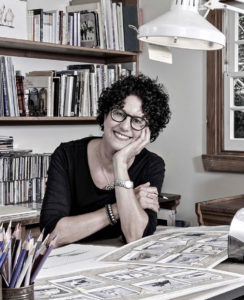 It’s always a treat when we get a picture book author who illustrates as well, and that’s exactly what we have with our January interview with Marla Frazee. (Witness two Caldecott Honors for her fine illustration work!) She was born and raised in LA, and has three grown sons who are off in the world, making her proud.
It’s always a treat when we get a picture book author who illustrates as well, and that’s exactly what we have with our January interview with Marla Frazee. (Witness two Caldecott Honors for her fine illustration work!) She was born and raised in LA, and has three grown sons who are off in the world, making her proud.
To get to know her a little bit better, let’s play seven truths and one lie. Here we go!
Marla:
- created the artwork for Sara Pennypacker’s bestselling Clementine series.
- had a childhood pet—a dog named Pappy who ran away at top speed every chance he got.
- refused to go to nursery school (and found kindergarten terrifying!).
- had to go to detention for wearing a clown costume to a high school assembly.
- was a contestant on Art Linkletter’s “Kids Say the Darnedest Things” TV show.
- has a Little Free Library in her front yard.
- authored The Boss Baby, which was adapted into a Dreamworks movie of the same name.
- works in a red-doored studio in her backyard beneath an avocado tree.
Want to know which one is the falsehood? Read on and find out! The answer will be in the interview below.
RVC: What was the picture book that set you on the path to being a picture book maker?
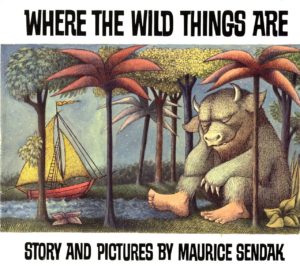 MF: It was, without a doubt, Where the Wild Things Are. I was 8 years old when it came out. I loved books, loved to draw, and was already planning to be a children’s book author and illustrator, but the moment I saw Max’s bedroom turn into a forest in just three page turns, well… it sealed the deal. I just wanted to learn how to make that sort of magic happen.
MF: It was, without a doubt, Where the Wild Things Are. I was 8 years old when it came out. I loved books, loved to draw, and was already planning to be a children’s book author and illustrator, but the moment I saw Max’s bedroom turn into a forest in just three page turns, well… it sealed the deal. I just wanted to learn how to make that sort of magic happen.
It’s still my favorite book of all time and I’m still trying to figure out how Sendak did what he did in it.
RVC: I’m sure you’ve been asked this before—are you a writer who does art, or an artist who writes?
MF: I’m an illustrator who tells stories with pictures—and often words.
RVC: What kind of training did you have for your writing and your art?
MF: I went to ArtCenter College of Design in Pasadena, CA, and received a BFA in Illustration. I’ve attended as many SCBWI (Society of Children’s Writers and Illustrators) conferences as I could. I’m also a long-time subscriber to The Horn Book Magazine which has given me a sense of both publishing history and its current state, notable books and the people who make them, and some understanding about why certain books get great reviews and others don’t. When I had children and read a bazillion books to them over the years, I developed my own passionate opinions about which children’s books worked and which didn’t. That’s been my training!
RVC: It took a while for you to break into picture books.
MF: It did take a while! No one could ever say I was an overnight success!
RVC: What kinds of things did you do along the way before landing that first book deal?
MF: I worked at Disney Studios after I graduated and quickly realized it wasn’t for me. I quit after 6 weeks to become a freelancer—and that’s what I’ve been doing ever since. In the years after that, I did whatever kind of illustration job I could get: textbook and mass-market books for kids, editorial illustration, advertising, greeting cards, and stuff like McDonald’s Happy Meals boxes and kid-friendly mascots for every team in the National Football League. But during all those years, I was trying to get published. I just wanted to make picture books.
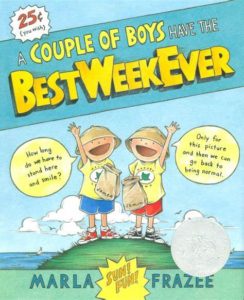 RVC: You’ve had incredible success as an illustrator for picture books, having received a Caldecott Honor for All the World and A Couple of Boys Have the Best Week Ever. How aware were you of those books being special during their making?
RVC: You’ve had incredible success as an illustrator for picture books, having received a Caldecott Honor for All the World and A Couple of Boys Have the Best Week Ever. How aware were you of those books being special during their making?
MF: I’m not sure how this will sound, but I always think the book I’m working on is special. If I don’t, I’ll keep revising until I do. And if I still don’t, as painful as it is, I put it away. The thing I am most surprised about, honestly, is which of my books do end up connecting more than others. I am the worst judge of how a book of mine will do once it is out in the world.
RVC: Liz Garton Scanlon did an interview with OPB in 2018—she’s terrific. What was the biggest challenge you faced in illustrating her manuscript All the World?
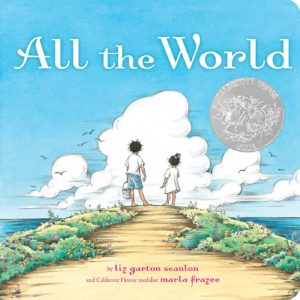 MF: Liz IS terrific. I’m with you on that!
MF: Liz IS terrific. I’m with you on that!
RVC: Absolutely!
MF: Back to the previous question, I was immediately aware that her manuscript for All the World read like a classic. The biggest challenge I faced was getting my head around the title. I mean, a book about ALL the world? I knew I couldn’t illustrate a book about all the world. So I thought about what it was like to feel a part of the world—to be somewhere you love with people you love—and illustrated that.
It took a while to figure out. I dumped a nearly finished sketch dummy and started over. Our editor, Allyn Johnston of Beach Lane Books, kept both Liz and me on track through a number of revisions. Allyn had a sense of the emotional power of All the World from the start. She was instrumental in how that book came to be.
RVC: How is the process different with illustrating your own books versus the books of others?
MF: I love alternating between doing one of my own books and then illustrating someone else’s words. The process is very different. If it’s my own, I’m moving back and forth between pictures and words. It’s usually a big mess and I often don’t know it will come together. On the other hand, when I say yes to a manuscript, it’s already written. And it intrigues me, challenges me, and isn’t anything that I could’ve come up with myself. My job is to bring the picture story to a place where it is an equal partner to the words. It feels acrobatic.
RVC: How many books are you typically working on at the same time, and how long do they generally take?
MF: I typically work on one book at a time and once I’m actively in process (as opposed to marinating), each book usually takes a year.
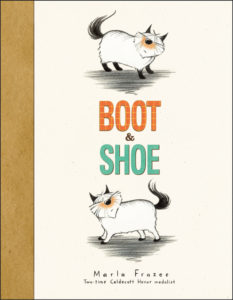 RVC: Let’s talk about Boot & Shoe. On one paw, it’s a funny dog bromance, but on the other paw—like so much of your work—there’s wit and wisdom, as well. How did this interesting story come about?
RVC: Let’s talk about Boot & Shoe. On one paw, it’s a funny dog bromance, but on the other paw—like so much of your work—there’s wit and wisdom, as well. How did this interesting story come about?
MF: Ha! Well asked!
Let’s see. I was teaching my Children’s Book Illustration class at ArtCenter, something I’ve done on and off for 25 years, and I listened as a student read Blueberries for Sal to the class. I love that book and it’s been a major influence in my own work, but this was the first time since I was a child that anyone read it aloud to me. I was thinking about how hilarious it is when we, the reader, know what’s going on but the characters don’t. Little Sal is following Little Bear’s mom and Little Bear is following Little Sal’s mom, and they don’t know it yet! But we do!
I decided right then that I wanted to make a book like that. I remembered how fun and funny it was to play hide-and-seek around a tree; one person going one way, the other person going the opposite way. That’s how the idea started.
RVC: Which of your books surprised you the most in terms of how it came out?
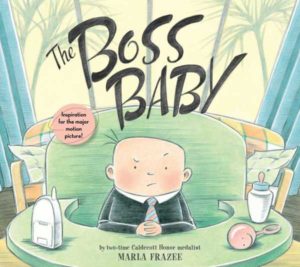 MF: The Boss Baby was one of the hardest books to figure out. It was funny in concept but unfunny for a long time in execution. The baby character needed to be cute, but not-cute. The tone needed to be understood by a child, but sophisticated. The setting needed to be contrived, but realistic. I almost gave up on it. Obviously, I’m very glad it finally worked.
MF: The Boss Baby was one of the hardest books to figure out. It was funny in concept but unfunny for a long time in execution. The baby character needed to be cute, but not-cute. The tone needed to be understood by a child, but sophisticated. The setting needed to be contrived, but realistic. I almost gave up on it. Obviously, I’m very glad it finally worked.
RVC: I think it’s fair to say that you might be best known–beyond the kidlit world—for The Boss Baby movie. How did that all happen?
MF: I heard that DreamWorks animation was interested in optioning The Boss Baby right before the book was published. I was thrilled, of course, but didn’t take this to mean a feature length film would actually be made. I know there are a lot of hurdles. But we just kept hearing good news about where it was in first the development process, and then in the production process.
During these years, DreamWorks invited me to the studio a number of times to meet the filmmakers and see the progress. It was an incredible experience to watch how much love, care, and talent went into it all. I always left completely blown away and inspired.
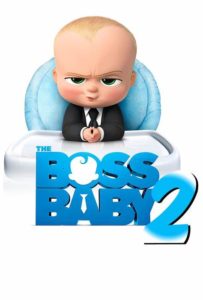 RVC: Just the other day, I saw that the movie sequel is coming out in late 2021, and there’s the Netflix TV show that’s been going for a few years now. How involved are you in the spinoffs?
RVC: Just the other day, I saw that the movie sequel is coming out in late 2021, and there’s the Netflix TV show that’s been going for a few years now. How involved are you in the spinoffs?
MF: I was invited to see the sequel a few months ago when it was about 60% finished and had a great conversation with the producer afterward, but I have no creative involvement with the Boss Baby films or TV show. I’m more like a soccer mom. I sit on the sidelines and cheer.
RVC: You once said that kids read the pictures in a picture book in a way that adults no longer can. What does that mean?
MF: Kids really read pictures. For story. For meaning. They see everything. No detail escapes them. They’re experts at it.
I think that once we learn to read words, this picture-reading skill lessens and words take precedence. By the time we’re grownups, we aren’t all that great at reading pictures. We see them, sure, but we don’t study them the way kids do. I feel honored and humbled to be working for an audience of picture-reading experts.
RVC: You’re really good at working the page turn—something would-be picture book writers often ignore or struggle with. What’s your secret?
MF: What a nice thing to say! I work on thumbnails sketches for months and months to get the pagination right. The picture book form is a beautiful challenge and the page turn is one of its most unique and important features.
RVC: One final question for the “serious” part of the interview. What’s something you’re working on now that you’re really excited about?
MF: I’m trying to get a project to work. And I’m afraid it might not work. So “excited” isn’t something I’m feeling yet. More like determined. I’m really determined. I can’t talk about it yet.
RVC: I understand completely. With my own writing, I keep things quiet until that’s no longer an option, one way or another. Best of luck with it!
MF: Thanks!
RVC: Okey dokey, Marla. You’ve been waiting for it, and now it’s here—the Speed Round! Zoomy questions and zippy answers, please! Are you ready?
MF: I’m not too zippy, but sure…
RVC: Star Trek, Star Wars, or Stargate?
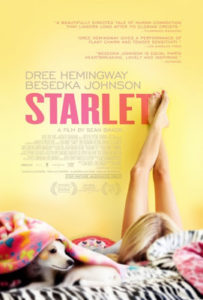 MF: None of the above. But have you ever seen the 2012 Sean Baker film Starlet? I loved that!
MF: None of the above. But have you ever seen the 2012 Sean Baker film Starlet? I loved that!
RVC: Best place in Pasadena for California pizza?
Casa Bianca Pizza Pie in Eagle Rock (which is Pasadena-adjacent; the neighboring town). Get the eggplant pizza.
RVC: Who would’ve been your Dream Author to illustrate for?
MF: Ruth Krauss.
RVC: What’s your go-to art tool?
MF: An eraser, maybe? I erase A LOT!
RVC: What’s the last picture book you read that totally WOWed you?
 MF: I was blown away by The Important Thing About Margaret Wise Brown, written by Mac Barnett and illustrated by Sarah Jacoby. The way it was written and the way it was illustrated and the person it is about. My god. I felt that it was an innovative and expertly crafted as Margaret Wise Brown’s work was and because of that, it honored her legacy in every way possible.
MF: I was blown away by The Important Thing About Margaret Wise Brown, written by Mac Barnett and illustrated by Sarah Jacoby. The way it was written and the way it was illustrated and the person it is about. My god. I felt that it was an innovative and expertly crafted as Margaret Wise Brown’s work was and because of that, it honored her legacy in every way possible.
RVC: Three words that sum up your picture book philosophy.
MF: Go for emotion.
RVC: Thanks so much, Marla! And for those who really want to know which of the bio “facts” in the introduction was actually a falsehood, the answer is…
MF: I wasn’t on Art Linkletter’s TV show, but my best friend Lisa Gilden was. She won a bunch of prizes that we played with together. I recall a toy vacuum cleaner and a croquet set. Obviously the croquet set was more fun!
RVC: For those of you who didn’t notice, the above falsehood means that Marla WAS sent to detention “for wearing a clown costume to a high school assembly.” And Marla was nice enough to include a photo by way of proof. What better way to end this interview than that? Thanks, Marla!!
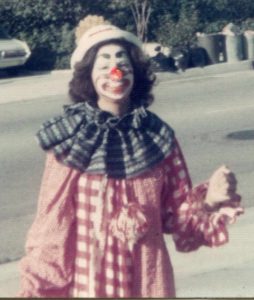

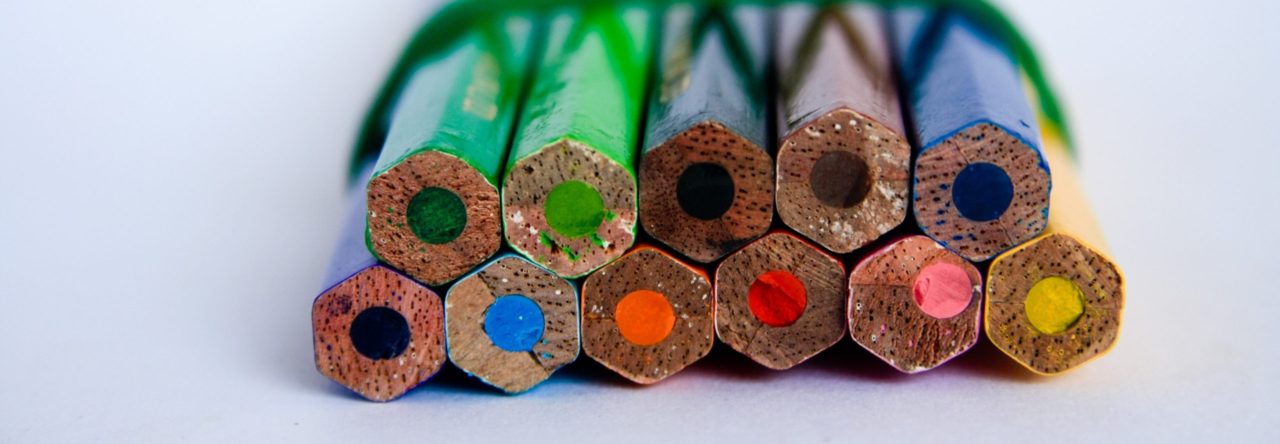
WOW! I did not know that Boss Baby was a book before a movie. That is so cool! This was an awesome interview. Thanks for sharing it!